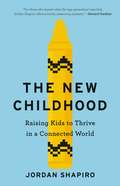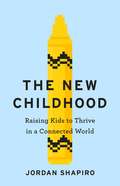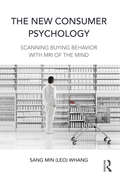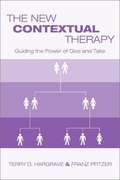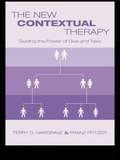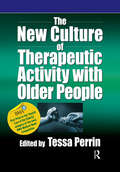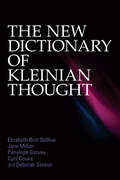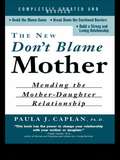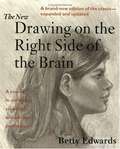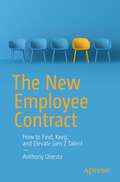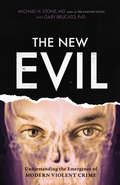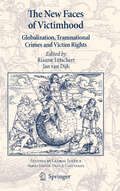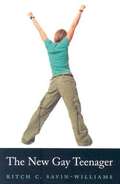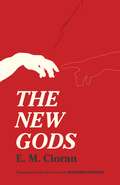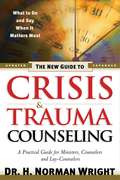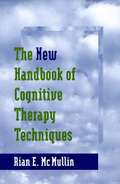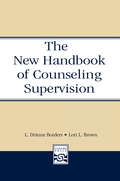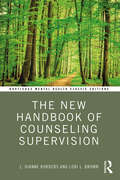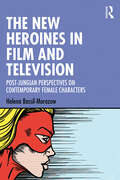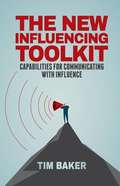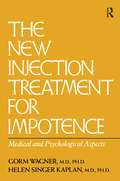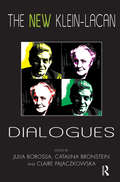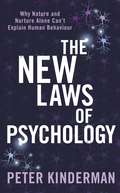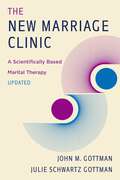- Table View
- List View
The New Childhood: Raising Kids to Thrive in a Connected World
by Jordan ShapiroA provocative look at the new, digital landscape of childhood and how to navigate it.In The New Childhood, Jordan Shapiro provides a hopeful counterpoint to the fearful hand-wringing that has come to define our narrative around children and technology. Drawing on groundbreaking research in economics, psychology, philosophy, and education, The New Childhood shows how technology is guiding humanity toward a bright future in which our children will be able to create new, better models of global citizenship, connection, and community.Shapiro offers concrete, practical advice on how to parent and educate children effectively in a connected world, and provides tools and techniques for using technology to engage with kids and help them learn and grow. He compares this moment in time to other great technological revolutions in humanity's past and presents entertaining micro-histories of cultural fixtures: the sandbox, finger painting, the family dinner, and more. But most importantly, The New Childhood paints a timely, inspiring and positive picture of today's children, recognizing that they are poised to create a progressive, diverse, meaningful, and hyper-connected world that today's adults can only barely imagine.
The New Childhood: Raising kids to thrive in a digitally connected world
by Jordan ShapiroIT'S TIME FOR A NEW APPROACH TO SCREEN TIME.Jordan Shapiro believes we need to rethink parental attitudes to technology. There's a damaging orthodoxy that presents screen-time as the ultimate modern parenting evil and the only acceptable response to it is restriction. Shapiro, psychologist, educational pioneer and father of two, draws on cutting-edge research in education, philosophy, neuroscience and psychology to show we've let fear and nostalgia stand in the way of our children's best interests. In his optimistic, inspiring and practical guide to the new, digital frontier of childhood, he reframes gaming, social media and smartphones to offer fresh, evidence-based advice on how to take a more progressive approach.*Winner of the Spirituality & Practice Book Award as one of the 50 Best Spiritual Books of 2018.*'Shapiro successfully transforms our worst fears about screen time into excitement about the potential for redesigning childhood around our latest technologies ... It's a necessary book that I urge you to read.' - The Telegraph'Shapiro knows what he's talking about ... Shapiro's arguments are compelling' - USA Today'a thought-provoking, bold read. As a father of two daughters at similar ages to Jordan's children (7 and 9), facing similar challenges and dilemmas, the book provided me with an inspiring and optimistic perspective that's rare in the current media landscape.' - Variety'Timely, essential, and thought-provoking, The New Childhood is the must-read parenting guide for raising 21st century, digitally driven kids. Instead of raising a white flag and giving in to social media and the Internet, Jordan Shapiro tells parents how to embrace technology, stay involved in their children's lives, and prepare them for their future. Read it! I promise you'll rethink your parenting. I couldn't put it down' - Michele Borba, EdD, author of UnSelfie: Why Empathetic Kids Succeed In Our All-About-Me World
The New Consumer Psychology: Scanning buying behavior with MRI of the mind
by Sang Min WhangThe term ‘consumption’ is generally thought of as process by which individuals purchase goods and services. The New Consumer Psychology attempts to explain consumption as a social behavior that satisfies individual values and desires. In modern society, individual needs are no longer determined solely by age or gender, but by the life values and desires that one pursues. This book uncovers people's subjective experiences of consumption in the capitalist society with interesting inside stories ranging from politics to designer handbags. <P><P>The book also provides valuable consumer insights into business and individuals by going beyond the limitations of population statistics and demonstrates Q-methodology is used to analyse consumers’ subjective responses. This book is an interesting take on how we should shift our focus from products to people and explains why identification and interpretations of different consumer groups are important in smart targeting. Its content will definitely inspire marketing strategies and market effectiveness.
The New Contextual Therapy: Guiding The Power Of Give And Take
by Terry D. Hargrave Franz PfitzerThrough detailing and examining the four interplaying dimensions of relationships, Contextual Theory gives therapists the ability to reshape human relationships and solve problems using the strengths of trust, fairness, and freedom. Not just a review of what came before, this brief clinical guide demystifies the Contextual Theory of family counseling for practitioners and students in language that is succinct and lucid in order to expose a whole new generation of therapists to this important approach to family therapy.
The New Contextual Therapy: Guiding the Power of Give and Take
by Terry D. Hargrave Franz PfitzerThrough detailing and examining the four interplaying dimensions of relationships, Contextual Theory gives therapists the ability to reshape human relationships and solve problems using the strengths of trust, fairness, and freedom. Not just a review of what came before, this brief clinical guide de-mystifies the Contextual Theory of family counseling for practitioners and students in language that is succinct and lucid in order to expose a whole new generation of therapists to this important approach to family therapy.
The New Culture of Therapeutic Activity with Older People (Speechmark Editions)
by Tessa PerrinOnce viewed as entertainment, activity provision is increasingly being seen as of therapeutic value and an integral part of quality care practice. This change has been so rapid and far-reaching that many staff teams have been left behind, attempting to address new culture requirements with old culture knowledge. This book clarifies and illuminates the changes that have been taking place in the field of activity provision over recent years, and offers a guideline to those who are endeavouring to catch up. The contents include: the difference between old culture and new culture thinking and practice; the new culture from the perspective of the politician, the manager, the care assistant, the activity provider, the researcher, the trainer, the community worker and the activity charity. Between them, the contributors bring a breadth of experience of the changing culture that spans more than three decades. The contributors include: Tessa Perrin; Rosemary Hurtley; Keena Millar Sylvie Silver; Paul Smith; Hazel May; Charlie Murphy; Vivienne Ratcliffe; Kenneth Hawes; Helen Crumpton; Carline Ryder-Jones, Wendy Ferguson Rebecca Colledge; Richard Mepham; Sally Knocker; Simon Labbett. This is a vital resource for all staff and management of care settings for older people.
The New Dictionary of Kleinian Thought
by Jane Milton Deborah Steiner Penelope Garvey Cyril Couve Elizabeth Bott SpilliusThe New Dictionary of Kleinian Thought provides a comprehensive and wholly accessible exposition of Kleinian ideas. Offering a thorough update of R.D. Hinshelwood’s highly acclaimed original, this book draws on the many developments in the field of Kleinian theory and practice since its publication. The book first addresses twelve major themes of Kleinian psychoanalytic thinking in scholarly essays organised both historically and thematically. Themes discussed include: unconscious phantasy, child analysis the paranoid schizoid and depressive positions, the oedipus complex projective identification, symbol formation. Following this, entries are listed alphabetically, allowing the reader to find out about a particular theme - from Karl Abraham to Whole Object - and to delve as lightly or as deeply as needed. As such this book will be essential reading for psychoanalysts, psychotherapists as well as all those with an interest in Kleinian thought.
The New Don't Blame Mother: Mending the Mother-Daughter Relationship
by Paula CaplanFirst Published in 2000. Routledge is an imprint of Taylor & Francis, an informa company.
The New Drawing on the Right Side of the Brain (Revised and Expanded Third Edition)
by Betty EdwardsTranslated into thirteen languages, Drawing on the Right Side of the Brain is the world's most widely used drawing-instruction guide. People from just about every walk of life--artists, students, corporate executives, architects, real estate agents, designers, engineers--have applied its revolutionary approach to problem solving.
The New Employee Contract: How to Find, Keep, and Elevate Gen Z Talent
by Anthony OnestoLearn about Generation Z from the perspective of a manager at a company looking to recruit and retain staff. This book provides an in-depth analysis of who makes up Gen Z, what they want, and how businesses around the world can give that to them in a way that is meaningful. In the past, companies were not prepared for the generation of new talent called Millennials. Companies were surprised to learn that Millennials were different from those in Gen X and the Boomers. With the help of author Anthony Onesto, you will not be unprepared when working with those in Gen Z. The New Employee Contract dives into the needs and wants of this generation of talent that has been born on the iPhone and for whom gaming is second nature. Those in GenZ believe in loyalty and social goodness, use gaming mechanisms, and expect almost real-time delivery on their expectations. The patience of this generation is very short, which explains the success of platforms such as Snapchat and TikTok. All of this research is presented in a fun, compelling way in this book. Even if you are not working in management, you will want to understand these 74 million socially active Americans who hold $44 billion in direct buying power. What You Will Learn Understand what members of Gen Z want in a world of climate uncertainty, job losses, and automation Understand why automation is a worst case scenario for those in Gen Z Know how to give back a sense of control to those who belong to Gen Z Know what members of Gen Z are looking for, including quality of work vs. quantity of work Be aware of the way businesses need to develop this new contract with employees Who This Book Is For Chief executive officers, chief people officers/HR leaders/HR departments, and leaders/managers within companies. The book is also of use to venture capitalists, those handling private equity, and investors. A third audience includes college advisors, life coaches, and career coaches.
The New Evil: Understanding the Emergence of Modern Violent Crime
by Michael H. Stone Gary BrucatoA CHILLING FOLLOW-UP TO THE POPULAR TRUE CRIME BOOK THE ANATOMY OF EVILRevisiting Dr. Michael Stone's groundbreaking 22-level Gradations of Evil Scale, a hierarchy of evil behavior first introduced in the book The Anatomy of Evil, Stone and Dr. Gary Brucato, a fellow violence and serious psychopathology expert, here provide even more detail, using dozens of cases to exemplify the categories along the continuum. The New Evil also presents compelling evidence that, since a cultural tipping-point in the 1960s, certain types of violent crime have emerged that in earlier decades never or very rarely occurred. The authors examine the biological and psychiatric factors behind serial killing, serial rape, torture, mass and spree murders, and other severe forms of violence. They persuasively argue that, in at least some cases, a collapse of moral faculties contributes to the commission of such heinous crimes, such that "evil" should be considered not only a valid area of inquiry, but, in our current cultural climate, an imperative one. They consider the effects of new technologies and sociological, cultural, and historical factors since the 1960s that may have set the stage for "the new evil." Further, they explain how personality, psychosis, and other qualities can meaningfully contribute to particular crimes, making for many different motives.Relying on their extensive clinical experience, and examination of writings and artwork by infamous serial killers, these experts offer many insights into the logic that drives horrible criminal behavior, and they discuss the hope that in the future such violence may be prevented.
The New Faces of Victimhood
by Rianne Letschert Jan Van DijkBesides generating wealth, globalization makes victims, including victims of new forms of crime. In this edited book of scholarly essays, international lawyers and criminologists reflect on the legal challenges posed by these dark sides of globalization. Examples include transnational organised crime, human trafficking and corruption, cyber crimes, international terrorism, global corporate crime and cross-border environmental crimes. The authors reflect on the limits of domestic systems of justice in providing protection, empowerment and redress to the victims of these emerging forms of global insecurity. They argue for the need of better international or supra-national institutional arrangements such as legal instruments and actions of the United Nations or regional organizations such as the European Union. In part I Jan Van Dijk and Rianne Letschert present an overview of trends in criminal victimization against the backdrop of globalization using a unique set of statistical indicators. By placing this issue in the framework of the human security concept, the authors draw out its broader political and normative implications. Theologist Ralf Bodelier explains how modern communication technologies have heightened sensitivities among the general public for human insecurities anywhere in the world. In his view, a new global conscience is in the making that may become the cornerstone of international solidarity and action. Marc Groenhuijsen and Rianne Letschert describe the emergence of national and international legal and institutional arrangements to offer remedies to victims of crime in an era of globalization. In part II a selection of experts analyse the specific issues surrounding the protection and empowerment of victims of different types of international crimes such as human trafficking, organised crime/corruption, terrorism, global corporate crime and cross border environmental crimes. In part III focused attention is given to the special challenges and opportunities of protecting and assisting crime victims in cyberspace. Part IV deals with emerging victim issues in humanitarian law such as the accountability of private military companies and the implementation of the ambitious victim provisions in the statute of the International Criminal Court including the establishment of a global fund for reparations. In the final part of the book some of its core authors formulate their ideas about the international institutional arrangements that should be put in place to offer justice to the victims of globalization. A concrete proposal is made for the transformation of the United Nations 1985 Declaration on the Principles of Justice for Victims of Crime and Abuse of Power into a full-fledged UN convention. In the final chapter further proposals are made for the increased involvement of regional organisations such as the European Union in the protection of victims of global crime.
The New Gay Teenager
by Ritch C. Savin-WilliamsIn this down-to-earth book, filled with the voices of young people speaking for themselves, Ritch Savin-Williams argues that the standard image of gay youth presented by mental health researchers--as depressed, isolated, drug-dependent, even suicidal--may have been exaggerated even twenty years ago, and is far from accurate today.
The New Gods
by E. M. CioranDubbed OC Nietzsche without his hammerOCO by literary critic James Wood, the Romanian philosopher E. M. Cioran is known as much for his profound pessimism and fatalistic approach as for the lyrical, raging prose with which he communicates them. Unlike many of his other works, such as "On the Heights of Despair" and "Tears and Saints," "The New Gods" eschews his usual aphoristic approach in favor of more extensive and analytic essays. aReturning to many of CioranOCOs favorite themes, "The New Gods "explores humanityOCOs attachment to gods, death, fear, and infirmity, in essays that vary widely in form and approach. In OC PaleontologyOCO Cioran describes a visit to a museum, finding the relatively pedestrian destination rife with decay, death, and human weakness. In another chapter, Cioran explores suicide in shorter, impressionistic bursts, while OC The DemiurgeOCO is a shambolic exploration of manOCOs relationship with good, evil, and God. All the while, "The New Gods "reaffirms CioranOCOs belief in OC lucid despair, OCO and his own signature mixture of pessimism and skepticism in language that never fails to be a pleasure. Perhaps his prose itself is an argument against CioranOCOs near-nihilism: there is beauty in his books. "
The New Guide to Crisis and Trauma Counseling
by H. Norman WrightAn informative and practical guide for beginning or lay counselors and those in situations that require immediate action in emergency situations. This relaunch of Crisis Counseling is upgraded and expanded, with new material and anecdotes in chapters that cover the areas of crisis intervention, how to counsel the depressed, the suicidal, and those going through divorce, children and adolescents crisis, and more. This classic volume on the trauma of loss and grief provides excellent instruction on what to do for others in the first 72 hours following a crisis for those who are helpless to help themselves.
The New Handbook of Cognitive Therapy Techniques
by Rian E. McmullinFor therapists with a good grounding in the approach, Hawaii-based clinical psychologist McMullin describes, explains, and demonstrates over 100 techniques of cognitive therapy. For each he provides the theoretical basis, a thumbnail description, case examples, and resources for further information. He here adds seven new chapters to his 1986 Handbook of Cognitive Therapy Techniques that explain how to teach basic concepts, uncover harmful schemas, and resynthesize historical and cultural beliefs. Annotation c. Book News, Inc., Portland, OR (booknews.com)
The New Handbook of Counseling Supervision
by Lori L. Brown L. DiAnne BordersThe second edition of this ground-breaking book continues the mission of its predecessor: to provide a "best principles" and "best practices" overview of the counseling supervision process, one that is firmly rooted in the recent explosion of empirical research in this field. Sponsored by the Association for Counselor Education and Supervision (ACES), the presentation is targeted primarily at master's-level practitioners who want "how-to" applications of the research literature (with examples) rather than a comprehensive review of the supervision literature. Like the first edition, this revised book is also a useful supplement for more academic texts used for doctoral-level instruction in counseling supervision.Key changes in this new edition include greater attention to multicultural and diversity issues and new chapters on group supervision and on technology. Also new are discussion questions and vignettes meant to enhance application of key concepts in each chapter as well as more sample materials and forms for practice.
The New Handbook of Counseling Supervision (Routledge Mental Health Classic Editions)
by Lori L. Brown L. DiAnne BordersThe classic edition of this groundbreaking book includes a new preface from the authors discussing developments in the field since the handbook’s initial publication. Chapters provide an overview of best principles and best practices in counseling supervision process, one that is firmly rooted in the recent explosion of empirical research in this field. Sponsored by the Association for Counselor Education and Supervision (ACES), the book is targeted primarily at master's-level practitioners who want practical, how-to applications of the research literature rather than a comprehensive review of the supervision literature. It's also a useful supplement for more academic texts used for doctoral-level instruction in counseling supervision.
The New Heroines in Film and Television: Post-Jungian Perspectives on Contemporary Female Characters
by Helena Bassil-MorozowThis thought-provoking volume offers an overview of contemporary representations of prominent female characters as they appear in an array of moving-image narratives from a Jungian and post-Jungian perspective. Applying a theoretical frame that is richly informed by the Jungian and post-Jungian concepts of persona, individuation, and archetypes, works including Fleabag (2016-2019), Ladybird (2017), and The Queen’s Gambit (2020) as well as Disney productions such as Brave (2012), Moana (2016), and Frozen (2013), are contextualized and discussed alongside their non-screen precedents and contemporaries, including myths, fairy tales, and works of literature, to closely examine new patterns of the female journey. This book identifies how young female characters rebel against the female persona of previous eras through the trickster, the shadow, and other archetypes, comparing the contemporary female protagonist with her predecessors to assess the new paths, roles, and milestones available to her. Examining the construction of the female persona across time periods and mediums in an accessibly written yet academic style, this book is the first of its kind. With a fulsome account of the progressive developments in entertainment media and Jungian thought, this book is essential reading for students and scholars of film, as well as anyone with an interest in analytical psychology and wider feminist issues in contemporary culture.
The New Influencing Toolkit
by Tim BakerWithout influence, managers are ineffective. In today's workplace, managers need to influence up, down and increasingly, sideways as organizations become less hierarchical. This book is expertly designed to diagnose and develop managerial influence, focusing on four key strategies: investigating, calculating, motivating and collaborating.
The New Injection Treatment For Impotence: Medical And Psychological Aspects
by Gorm Wagner Helen Singer KaplanIn this volume, two experts on sexual disorders describe the most effective treatment yet developed for male impotence. The authors review both the medical and the psychiatric aspects of injection treatment for men of all ages, with particular attention to older men and those with psychogenic impotence. The authors also discuss ethical considerations.
The New Klein-Lacan Dialogues
by Julia BorossaThis book provides a timely exploration and comparison of key concepts in the theories of Melanie Klein and Jacques Lacan, two thinkers and clinicians whose influence over the development of psychoanalysis in the wake of Freud has been profound and far-reaching. Whilst the centrality of the unconscious is a strong conviction shared by both Klein and Lacan, there are also many differences between the two schools of thought and the clinical work that is produced in each. The purpose of this collection is to take seriously these similarities and differences. Deeply relevant to both theoretical reflection and clinical work, the New Klein-Lacan Dialogues should make interesting reading for psychoanalysts, psychotherapists, mental health professionals, scholars and all those who wish to know more about these two leading figures in the field of psychoanalysis.The collection centres around key concepts such as: 'symbolic function', the 'ego', the 'object', the 'body', 'trauma', 'autism', 'affect' and 'history and archives'.
The New Laws of Psychology: Why Nature And Nurture Alone Can't Explain Human Behaviour
by Peter KindermanThis controversial new book describes how human behaviour - thoughts, emotions, actions and mental health - can be largely explained if we understand how people make sense of their world and how that framework of understanding has been learned. In this ground-breaking book, Peter Kinderman, presents a simple, but radical new model of mental well-being. Published following the publication of the new edition of the controversial, Diagnostic and Statistical Manual, the author challenges notions such as 'mental illness' and 'abnormal psychology' as old-fashioned, demeaning and invalid, and argues that diagnoses such as 'depression' and 'schizophrenia' are unhelpful. Kinderman argues that one consequence of our current obsession with a medical approach to human well-being and distress, is that human problems are too often merely diagnosed and treated, rather than understood. Witten by an expert in his field, and accessible to all those interested in and affected by mental health issues, The New Laws of Psychology will change the way we define mental illness forever.
The New Laws of Psychology: Why Nature and Nurture Alone Can't Explain Human Behaviour
by Peter KindermanThis controversial new book describes how human behaviour - thoughts, emotions, actions and mental health - can be largely explained if we understand how people make sense of their world and how that framework of understanding has been learned. In this ground-breaking book, Peter Kinderman, presents a simple, but radical new model of mental well-being. Published following the publication of the new edition of the controversial, Diagnostic and Statistical Manual, the author challenges notions such as 'mental illness' and 'abnormal psychology' as old-fashioned, demeaning and invalid, and argues that diagnoses such as 'depression' and 'schizophrenia' are unhelpful. Kinderman argues that one consequence of our current obsession with a medical approach to human well-being and distress, is that human problems are too often merely diagnosed and treated, rather than understood. Written by an expert in his field, and accessible to all those interested in and affected by mental health issues, The New Laws of Psychology will change the way we define mental illness forever.
The New Marriage Clinic: A Scientifically Based Marital Therapy Updated (Second Edition)
by John M. Gottman Julie Schwartz GottmanThe widely celebrated, research-based marital therapy program—now updated and revised. The highly influential book The Marriage Clinic presented a complete marital therapy program based on John Gottman’s much-heralded research on marital success and failure. Since then, Dr. Gottman has collaborated with his wife, clinical psychologist Dr. Julie Gottman, to conduct their well-known Love Lab studies, allowing the pair to design a highly successful couples’ workshop and develop their Sound Relationship House theory. Now, in the book’s first-ever revision, Dr. Gottman and Dr. Gottman incorporate the results of their studies and their most powerful interventions. In addition to its original, celebrated marital therapy program, The New Marriage Clinic includes findings on the dynamics of same-sex couples, interventions for couples recovering from situational domestic violence, strategies for couples rebuilding their marriages after an affair, and much more. No relational therapist’s bookshelf is complete without this vital update to the groundbreaking guide on marital therapy.
